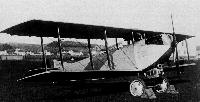
Описание
Страна : Франция
Год : 1921
Двухместный учебно-тренировочный самолет промежуточной подготовки
Caudron С.59 и С.60
Учебно-тренировочный самолет промежуточного уровня подготовки Caudron С.59 был обычным бипланом деревянной конструкции, с полотняной обшивкой и несмещенными друг относительно друга двухстоечными крыльями. Курсант размещался в открытой кабине под центральной секцией верхнего крыла, сразу же за ней - под вырезом в задней кромке верхнего крыла - находилась кабина инструктора. Самолет оснащался мотором Hispano-Suiza 8Ab с радиатором Lamblin, прикрепленным под фюзеляжем сразу перед основными стойками шасси.
Прототип выполнил первый полет в августе 1921 года. После обширных государственных испытаний французские ВВС заказали большую партию машин С.59 для использования в качестве машины категории Et.2 (двухместный учебно-тренировочный самолет промежуточного уровня подготовки). В конечном счете, французским военным поставили свыше 1000 самолетов С.59, а еще несколько партий таких самолетов попали в морскую авиацию. Самолеты этого типа служили во Франции в течение 15 лет, и на 1 января 1936 года в ВВС Франции все еще летали 11 таких машин. Всего изготовили до 1800 таких самолетов, многие из них попали во французские гражданские аэрошколы, а другие - поставлены ВВС ряда зарубежных стран.
Учебно-тренировочный самолет промежуточного уровня подготовки Caudron С.60 был очень похож на С.59, за исключением его силовой установки - ротативного мотора Clerget 9В мощностью 130 л. с. (97 кВт), который был установлен в носовой части фюзеляжа под подковообразным капотом. Французские военные отвергли самолет С.60, но он завоевал признание во французских гражданских аэрошколах, а также экспортировался в значительных количествах.
Вариант
С.59/2: одна машина со звездообразным мотором Lorraine 7Ма мощностью 230 л.с. (172 кВт) и с перепроектированным шасси с основными стойками с широкой колеей
ТАКТИКО-ТЕХНИЧЕСКИЕ ХАРАКТЕРИСТИКИ
Caudron C.59Et.2
Тип: двухместный учебно-тренировочный самолет промежуточной подготовки
Силовая установка: один V-образный двигатель Hispano-Suiza 8Ab мощностью 180 л. с. (134 кВт)
Летные характеристики: максимальная скорость на уровне моря 170 км/ч; продолжительность полета 3 ч 30 мин
Масса: пустого 700 кг; максимальная взлетная 988 кг
Размеры: размах крыла 10,24 м; длина 7,80 м; высота 2,90 м; площадь крыльев 26,00 м!
Описание:
- Caudron С.59 и С.60
- Flight, January 1923
THE PARIS AERO SHOW 1922
Фотографии
-
Авиация и Космонавтика 2016-03 / В.Ильин - ВВС Турции: вчера, сегодня, завтра
Первая турецкая женщина-летчик Сабиха Гёкчен
-
Мировая Авиация 84
Элероны устанавливались только на верхнее крыло С.59. Размах верхнего крыла был немного больше, чем у нижнего, только нижнее крыло имело поперечное "V", а с каждой стороны стояли по два комплекта бипланных стоек.
The one-off Caudron C-59, acquired in 1924. -
Flight 1921-09 / Flight
Tho Holder of the Michelin Cup: The Caudron C.60, on which Poiree made his flight, described in FLIGHT last week. This machine, which is one of the Caudron school types, can if desired be fitted with dual control. It is similar to the machine flown by Poiree at Monaco, except that wheels are fitted instead of floats. The engine is a 130 h.p. Clerget, and the main characteristics are as follows: Length over all, 24 ft. 7 ins. Span, upper plane,. 33 ft. 4 ins. Span, lower plane, 31 ft. 4 ins. Wing area, 270 sq. ft. Weight empty, 1,110 lbs Weight fully loaded, 1,900 lbs.
-
Flight 1921-12 / Flight
CAUDRON AT THE PARIS SHOW: The type 60 used by Poiree
-
Flight 1922-06 / Flight
IMITATING FORCED LANDINGS: Peuillot just clears the line on his Caudron.
-
Flight 1923-01 / Flight
Регистрационный номер: F-AEIH TWO CAUDRON SCHOOL MACHINES: Left, the 80 h.p. le Rhone machine; and right, the Hispano-engined biplane.
-
Flight 1923-01 / Flight
Регистрационный номер: F-ESAA TWO CAUDRON SPORTING TYPES: On the left the 45 h.p. two-seater, and on the right the 35 h.p. single-seater.
-
Flight 1921-12 / Flight
THE CAUDRON UNDERCARRIAGE: One side of the quickly-detachable undercarriage of the "C.59" and "C.60."
-
Flight 1923-01 / Flight
A divided strut is used in the Caudron sporting two-seater in connection with the wing-folding gear. When the wings are open the strut rests in a slot in the side of the fuselage.
-
Flight 1922-12 / Flight
Caudron Type C.59
-
Flight 1922-12 / Flight
Caudron Type C.27
-
Flight 1922-12 / Flight
Caudron Type C.67
-
Flight 1922-12 / Flight
Caudron Type C.68
- Фотографии












